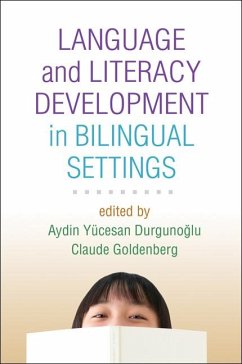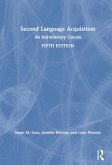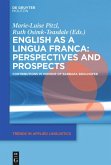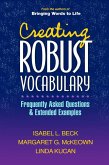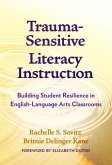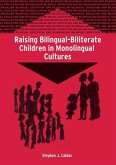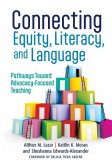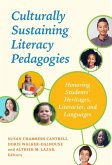Language and Literacy Development in Bilingual Settings
Herausgeber: Durgunoglu, Aydin Yücesan; Goldenberg, Claude
Language and Literacy Development in Bilingual Settings
Herausgeber: Durgunoglu, Aydin Yücesan; Goldenberg, Claude
- Gebundenes Buch
- Merkliste
- Auf die Merkliste
- Bewerten Bewerten
- Teilen
- Produkt teilen
- Produkterinnerung
- Produkterinnerung
Grounded in state-of-the-art research, this book explores how English language learners develop both the oral language and literacy skills necessary for school success. Chapters examine the cognitive bases of English acquisition, and how the process is different for children from alphabetic (such as Spanish) and nonalphabetic (such as Chinese) language backgrounds. The book addresses a key challenge facing educators and clinicians: identifying students whose poor English skills may indicate an underlying impairment, as opposed to still-developing language proficiency. Implications for diagnosis, intervention, and instruction are highlighted throughout.…mehr
Andere Kunden interessierten sich auch für
![Second Language Acquisition Second Language Acquisition]() Susan M GassSecond Language Acquisition175,99 €
Susan M GassSecond Language Acquisition175,99 €![English as a Lingua Franca: Perspectives and Prospects English as a Lingua Franca: Perspectives and Prospects]() English as a Lingua Franca: Perspectives and Prospects139,95 €
English as a Lingua Franca: Perspectives and Prospects139,95 €![Creating Robust Vocabulary Creating Robust Vocabulary]() Isabel L BeckCreating Robust Vocabulary47,99 €
Isabel L BeckCreating Robust Vocabulary47,99 €![Trauma-Sensitive Literacy Instruction Trauma-Sensitive Literacy Instruction]() Rachelle S SavitzTrauma-Sensitive Literacy Instruction108,99 €
Rachelle S SavitzTrauma-Sensitive Literacy Instruction108,99 €![Raising Bilingual-Biliterate Children Raising Bilingual-Biliterate Children]() Stephen J CaldasRaising Bilingual-Biliterate Children126,99 €
Stephen J CaldasRaising Bilingual-Biliterate Children126,99 €![Connecting Equity, Literacy, and Language Connecting Equity, Literacy, and Language]() Althier M LazarConnecting Equity, Literacy, and Language102,99 €
Althier M LazarConnecting Equity, Literacy, and Language102,99 €![Culturally Sustaining Literacy Pedagogies Culturally Sustaining Literacy Pedagogies]() Culturally Sustaining Literacy Pedagogies111,99 €
Culturally Sustaining Literacy Pedagogies111,99 €-
-
-
Grounded in state-of-the-art research, this book explores how English language learners develop both the oral language and literacy skills necessary for school success. Chapters examine the cognitive bases of English acquisition, and how the process is different for children from alphabetic (such as Spanish) and nonalphabetic (such as Chinese) language backgrounds. The book addresses a key challenge facing educators and clinicians: identifying students whose poor English skills may indicate an underlying impairment, as opposed to still-developing language proficiency. Implications for diagnosis, intervention, and instruction are highlighted throughout.
Produktdetails
- Produktdetails
- Verlag: Guilford Publications
- Seitenzahl: 363
- Altersempfehlung: 5 bis 17 Jahre
- Erscheinungstermin: 15. November 2010
- Englisch
- Abmessung: 233mm x 161mm x 32mm
- Gewicht: 641g
- ISBN-13: 9781606239544
- ISBN-10: 1606239546
- Artikelnr.: 30593601
- Herstellerkennzeichnung
- Libri GmbH
- Europaallee 1
- 36244 Bad Hersfeld
- gpsr@libri.de
- Verlag: Guilford Publications
- Seitenzahl: 363
- Altersempfehlung: 5 bis 17 Jahre
- Erscheinungstermin: 15. November 2010
- Englisch
- Abmessung: 233mm x 161mm x 32mm
- Gewicht: 641g
- ISBN-13: 9781606239544
- ISBN-10: 1606239546
- Artikelnr.: 30593601
- Herstellerkennzeichnung
- Libri GmbH
- Europaallee 1
- 36244 Bad Hersfeld
- gpsr@libri.de
Aydin Yücesan Durgunoglu, PhD, is Professor of Psychology at the University of Minnesota Duluth. She has worked as a high school teacher and as a college instructor of English as a foreign language. Her research addresses child literacy development in different languages as well as in bilingual contexts, adult literacy, and English literacy development of recent immigrants to the United States. Since 1995, as a consultant for the Mother Child Education Foundation in Istanbul, Dr. Durgunoglu has led the efforts to create an innovative adult literacy program in Turkey, which has now reached about 100,000 individuals across the country. Claude Goldenberg, PhD, is the Nomellini & Olivier Professor of Education in the Graduate School of Education at Stanford University. A native of Argentina, he conducts research on promoting academic achievement among language minority students. He is a recipient of the Albert J. Harris Award from the International Literacy Association and the Best Research Award from Learning Forward. He currently directs a randomized control trial in Rwanda evaluating an early literacy intervention created by Save the Children.
I. Introduction 1. Contexts for Language and Literacy Development among
Dual-Language Learners, Claude Goldenberg, Leslie Reese, and Ali Rezaei
II. Oral Language and Dual-Language Learners 2. The Role of First Language
on Oral Language Development in English: The Case of Both Alphabetic and
Nonalphabetic Languages, Stefka H. Marinova-Todd and Yuuko Uchikoshi 3.
Tuning in to Language-Specific Patterns: Nonword Repetition and the Big
Picture of Bilingual Vocabulary Learning, María R. Brea-Spahn and Elaine R.
Silliman 4. Rapid Spoken Language Shift in Early Second Language Learning:
The Role of Peers and Effects on the First Language, D. Kimbrough Oller,
Linda Jarmulowicz, Barbara Z. Pearson, and Alan B. Cobo-Lewis 5. Language
Proficiency and Its Implications for Monolingual and Bilingual Children,
Ellen Bialystok and Xiaojia FengIII. Literacy and Dual-Language Learners
6. Factors Affecting the Relative Relationships between First- and
Second-Language Phonological Awareness and Second Language Reading,
Alexandra Gottardo, Yan Gu, Julie Mueller, Iuliana Baciu, and Ana Laura
Pauchulo 7. Learning a Nonalphabetic Script and Its Impact on Later
Development of English as a Second Language, Him Cheung, Catherine
McBride-Chang, and Xiuli Tong 8. Chinese Language Learners of English Use
More Orthographic-Lexical Than Phonological Strategies in English Word
Recognition and Spelling, Che Kan Leong 9. Writing Acquisition among
English Language Learners in U.S. Schools, Laura Méndez Barletta, Janette
K. Klingner, and Michael J. Orosco IV. Assessment and Diagnosis 10.
Linguistic and Cognitive Processes in the Development of Spelling in
English Language Learners: First-Language Transfer, Language Proficiency,
or Cognitive Processes?, Esther Geva and Adèle Lafrance 11. Cognitive and
Oral Language Contributors to Reading Disabilities in Spanish-English
Bilinguals, Franklin R. Manis and Kim A. Lindsey 12. Assessment of Literacy
Problems among English Language Learners Based on the Component Model, R.
Malatesha Joshi and P. G. Aaron V. Conclusion 13. The Policy Context of
Research on Basic Processes in Bilingual Children in the United States,
Kenji Hakuta
Dual-Language Learners, Claude Goldenberg, Leslie Reese, and Ali Rezaei
II. Oral Language and Dual-Language Learners 2. The Role of First Language
on Oral Language Development in English: The Case of Both Alphabetic and
Nonalphabetic Languages, Stefka H. Marinova-Todd and Yuuko Uchikoshi 3.
Tuning in to Language-Specific Patterns: Nonword Repetition and the Big
Picture of Bilingual Vocabulary Learning, María R. Brea-Spahn and Elaine R.
Silliman 4. Rapid Spoken Language Shift in Early Second Language Learning:
The Role of Peers and Effects on the First Language, D. Kimbrough Oller,
Linda Jarmulowicz, Barbara Z. Pearson, and Alan B. Cobo-Lewis 5. Language
Proficiency and Its Implications for Monolingual and Bilingual Children,
Ellen Bialystok and Xiaojia FengIII. Literacy and Dual-Language Learners
6. Factors Affecting the Relative Relationships between First- and
Second-Language Phonological Awareness and Second Language Reading,
Alexandra Gottardo, Yan Gu, Julie Mueller, Iuliana Baciu, and Ana Laura
Pauchulo 7. Learning a Nonalphabetic Script and Its Impact on Later
Development of English as a Second Language, Him Cheung, Catherine
McBride-Chang, and Xiuli Tong 8. Chinese Language Learners of English Use
More Orthographic-Lexical Than Phonological Strategies in English Word
Recognition and Spelling, Che Kan Leong 9. Writing Acquisition among
English Language Learners in U.S. Schools, Laura Méndez Barletta, Janette
K. Klingner, and Michael J. Orosco IV. Assessment and Diagnosis 10.
Linguistic and Cognitive Processes in the Development of Spelling in
English Language Learners: First-Language Transfer, Language Proficiency,
or Cognitive Processes?, Esther Geva and Adèle Lafrance 11. Cognitive and
Oral Language Contributors to Reading Disabilities in Spanish-English
Bilinguals, Franklin R. Manis and Kim A. Lindsey 12. Assessment of Literacy
Problems among English Language Learners Based on the Component Model, R.
Malatesha Joshi and P. G. Aaron V. Conclusion 13. The Policy Context of
Research on Basic Processes in Bilingual Children in the United States,
Kenji Hakuta
I. Introduction 1. Contexts for Language and Literacy Development among
Dual-Language Learners, Claude Goldenberg, Leslie Reese, and Ali Rezaei
II. Oral Language and Dual-Language Learners 2. The Role of First Language
on Oral Language Development in English: The Case of Both Alphabetic and
Nonalphabetic Languages, Stefka H. Marinova-Todd and Yuuko Uchikoshi 3.
Tuning in to Language-Specific Patterns: Nonword Repetition and the Big
Picture of Bilingual Vocabulary Learning, María R. Brea-Spahn and Elaine R.
Silliman 4. Rapid Spoken Language Shift in Early Second Language Learning:
The Role of Peers and Effects on the First Language, D. Kimbrough Oller,
Linda Jarmulowicz, Barbara Z. Pearson, and Alan B. Cobo-Lewis 5. Language
Proficiency and Its Implications for Monolingual and Bilingual Children,
Ellen Bialystok and Xiaojia FengIII. Literacy and Dual-Language Learners
6. Factors Affecting the Relative Relationships between First- and
Second-Language Phonological Awareness and Second Language Reading,
Alexandra Gottardo, Yan Gu, Julie Mueller, Iuliana Baciu, and Ana Laura
Pauchulo 7. Learning a Nonalphabetic Script and Its Impact on Later
Development of English as a Second Language, Him Cheung, Catherine
McBride-Chang, and Xiuli Tong 8. Chinese Language Learners of English Use
More Orthographic-Lexical Than Phonological Strategies in English Word
Recognition and Spelling, Che Kan Leong 9. Writing Acquisition among
English Language Learners in U.S. Schools, Laura Méndez Barletta, Janette
K. Klingner, and Michael J. Orosco IV. Assessment and Diagnosis 10.
Linguistic and Cognitive Processes in the Development of Spelling in
English Language Learners: First-Language Transfer, Language Proficiency,
or Cognitive Processes?, Esther Geva and Adèle Lafrance 11. Cognitive and
Oral Language Contributors to Reading Disabilities in Spanish-English
Bilinguals, Franklin R. Manis and Kim A. Lindsey 12. Assessment of Literacy
Problems among English Language Learners Based on the Component Model, R.
Malatesha Joshi and P. G. Aaron V. Conclusion 13. The Policy Context of
Research on Basic Processes in Bilingual Children in the United States,
Kenji Hakuta
Dual-Language Learners, Claude Goldenberg, Leslie Reese, and Ali Rezaei
II. Oral Language and Dual-Language Learners 2. The Role of First Language
on Oral Language Development in English: The Case of Both Alphabetic and
Nonalphabetic Languages, Stefka H. Marinova-Todd and Yuuko Uchikoshi 3.
Tuning in to Language-Specific Patterns: Nonword Repetition and the Big
Picture of Bilingual Vocabulary Learning, María R. Brea-Spahn and Elaine R.
Silliman 4. Rapid Spoken Language Shift in Early Second Language Learning:
The Role of Peers and Effects on the First Language, D. Kimbrough Oller,
Linda Jarmulowicz, Barbara Z. Pearson, and Alan B. Cobo-Lewis 5. Language
Proficiency and Its Implications for Monolingual and Bilingual Children,
Ellen Bialystok and Xiaojia FengIII. Literacy and Dual-Language Learners
6. Factors Affecting the Relative Relationships between First- and
Second-Language Phonological Awareness and Second Language Reading,
Alexandra Gottardo, Yan Gu, Julie Mueller, Iuliana Baciu, and Ana Laura
Pauchulo 7. Learning a Nonalphabetic Script and Its Impact on Later
Development of English as a Second Language, Him Cheung, Catherine
McBride-Chang, and Xiuli Tong 8. Chinese Language Learners of English Use
More Orthographic-Lexical Than Phonological Strategies in English Word
Recognition and Spelling, Che Kan Leong 9. Writing Acquisition among
English Language Learners in U.S. Schools, Laura Méndez Barletta, Janette
K. Klingner, and Michael J. Orosco IV. Assessment and Diagnosis 10.
Linguistic and Cognitive Processes in the Development of Spelling in
English Language Learners: First-Language Transfer, Language Proficiency,
or Cognitive Processes?, Esther Geva and Adèle Lafrance 11. Cognitive and
Oral Language Contributors to Reading Disabilities in Spanish-English
Bilinguals, Franklin R. Manis and Kim A. Lindsey 12. Assessment of Literacy
Problems among English Language Learners Based on the Component Model, R.
Malatesha Joshi and P. G. Aaron V. Conclusion 13. The Policy Context of
Research on Basic Processes in Bilingual Children in the United States,
Kenji Hakuta

